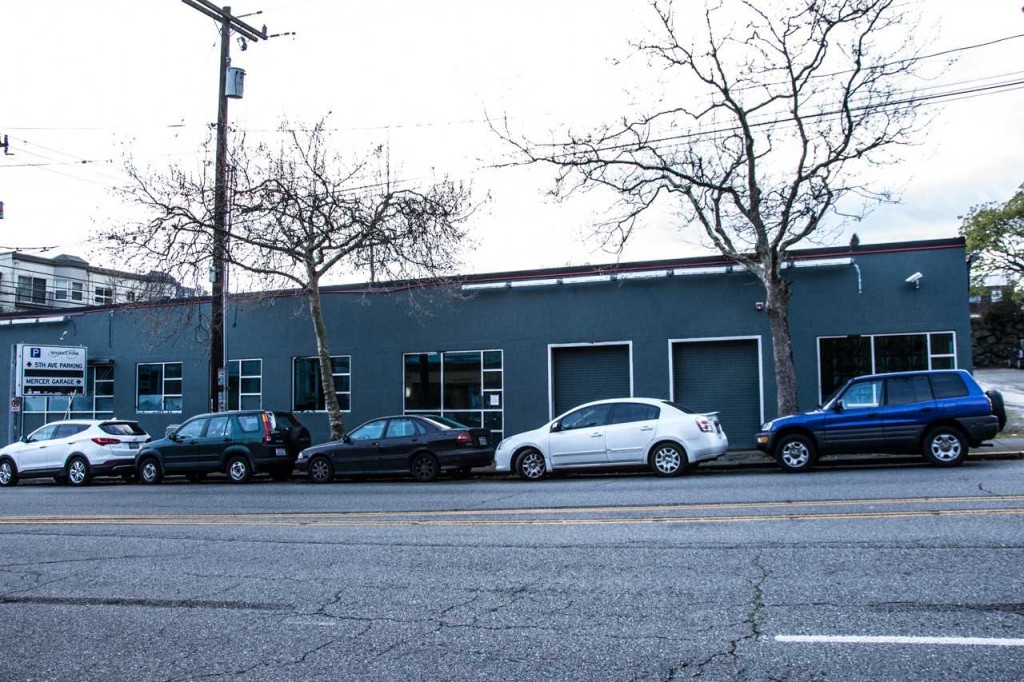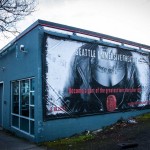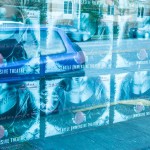Ivi drives us up a hilly street in the early semi-dark evening and drops us off at the venue, the “Undisclosed Seattle Warehouse” …
The first thing you notice is a rollup security door at the sidewalk, partially raised. The door is at the sidewalk toward one end of an unmarked single-story warehouse that shares the block only with an unimproved parking lot.
Walking through the roll-up door into a short dark passageway, with only doors announcing simply the name of the venue, we turn in a sharp left to a long dimly-lit, almost as though with candles, hallway past a barely-visible high counter and a receptionist who, almost before hearing our name, dispatches us down the long hallway and to a right turn.
Through a doorway we are suddenly presented with a large, about 65 by 80 feet, room in glistening white and brightly lit. About half a dozen columns extend from the floor to the 16 or 18 foot-high ceiling; gray-green theatrical masks hang from each. In the center of the vast room is a small two-tier stage, about eight by ten feet on its top layer. Against the walls of the space are chairs and settees and couches that suggest to me something from the Italian or European 18th century or thereabouts. Other attendees mill about, talking with each other or with a couple of dressed-in-black ladies staffing a small bar in the corner. (About 20 or 25 people seem to comprise the audience; the S.I.T. website specifies a maximum of about 40 per performance.) At the far wall opposite our entry point are a couple of doors for staff use and restrooms and to the right a wider opening to perhaps another hallway. For about 15 minutes we walked about the room, inspected the masks on display, ordered a drink of water, tried various seating and looked at an enormous coffee-table-sized photo book of the Queen of England.
Shortly after 8pm, a single bell stroke (gong? ding? clap?) sounded and a young man dressed in clerical garb (must be the Friar) dashed into the room and leaped onto the stage. He made the expected announcements about turning off phones and invited everyone to don a mask. Then he abruptly strode over to Kim, snatched her by the hand, pulled her toward the opening in the far corner, and commanded the rest of the audience to quickly follow.
Through the opening for a few steps and through another doorway brought us to a huge room — perhaps the town square of Verona — that was persistently dark, suggestive of a moonlight evening, but sparsely equipped with only gray concrete-like walls broken only by an occasional angle, with the suggestion of a tree in one corner and a slight mound of green. Toward one end was a two-foot-high circular structure wide enough to sit or stand upon, seeming to represent a well or fountain. The actors moved quickly throughout the broad space, often negotiating between and among audience members who stood around the outer walls or in small groups just inside the “town square”. No spotlights were in use; the actors emerged from the corners and the shadows and were in constant juxtaposition with the audience. As the scene came to a close, the last actor speaking suddenly grabbed the hand of the nearest audience member and scrambled through a curtained doorway, again entreating the audience to follow with alacrity.
Once through that doorway, we found ourselves in a large rectangular space, better lit this time, that turned out to be the bedroom of Juliet. At one end was her dressing table, and we met Nurse there as well. At the other was Juliet’s canopied bed where we would come to see her in various scenes, sleeping, hiding, jumping, and, of course, later abed with Romeo. Nurse grabbed me at the end of the first scene in that set and he made small talk as we led the audience to the next set.
The most ornate or decorated set was probably the church or chapel or was it the tomb where Juliet first conspired with the Friar to feign her death. It, too, was very dark but its black walls were covered with an overlay of cross symbols and a impressionistic pseudo-religious painting behind the altar or pulpit or whatever was up front. Two groups of pews faced that corner, separated by a central aisle. Again, at the conclusion of that scene, an actor sequestered a nearby audience member and herded us all into the next set. And so on throughout the night, returning as appropriate for scenes again at the town square or Juliet’s bedroom, etc. And the actors not only negotiated among the audience but often spoke their lines by directly addressing individual audience members.
Something of an intermission occurred (but the play never stopped) when we were rushed into the original white room where the people of Verona were in celebration and more plot between the feuding families of Juliet and Romeo was in play. Dancing, laughter, singing and acrobatics energized the scene. Actors mingled freely with audience at this point, and even offered up champagne and hors d’oeuvres and answered and asked questions on just about any topic, from explaining what was happening in the story, to their own roles and even personal lives, to current politics. The music was especially well-chosen, contemporary stuff mostly, hip-hop and beyond. High energy with a sense of foreboding.
The actors, all of them, were remarkable. Standouts for me were the players of Juliet, her mother — Lady Capulet (who performed in a briskly-moving wheelchair), Mercutio and certainly Tybalt/Melissa. And Romeo, in the scene where he/she procures poison from a local drug dealer, put forth a most memorable wail and howl upon learning of the alleged death of Juliet.
Everything was minimal and moody and I grieved for the absence of my camera, as I constantly saw in my mind’s eye incredible photograph after photograph. As luck would have it, I left the Nikon (and its ability to penetrate the darkness — Corbin knows what I am talking about here) behind, foregoing the opportunity to give play to my penchant for shadows and the noir.
Would I see this performance again? In a heartbeat.
Hopefully, the Seattle Immersive Theatre will publish some R + J scenes on YouTube or Vimeo. In the meantime, I did find trailers for a couple of the Theatre’s earlier productions, as follows:

